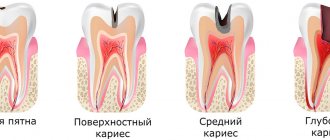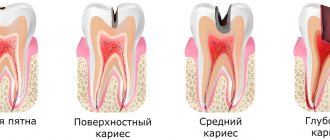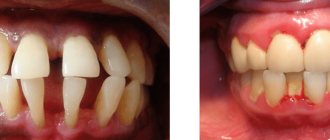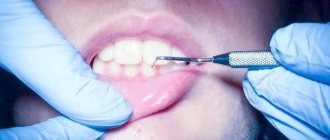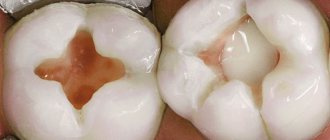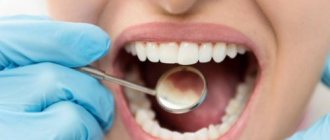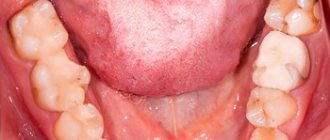Deep caries is the fourth and final stage of destruction and demineralization of hard tooth tissues. Looking at the photo of deep caries, you can immediately notice the presence of a carious hollow. From the outside it may seem small, but inside there is always significant destruction of dental tissue.
With deep caries, the carious cavity is separated from the pulp by only a narrow layer of dentin, which with further development of the disease can lead to the development of pulpitis, periodontitis or periostitis. Thus, the main task of the dentist is to preserve all the functions of the tooth and minimize the risk of developing these diseases.
Etiology
The medical history of deep caries may indicate the primary or secondary development of the disease. In the first case, it occurs due to the lack of professional treatment of the middle stage of caries, in the second - after tooth preparation (incorrect treatment, chipped filling). Otherwise, the factors stimulating the development of the disease are the same as for caries in general: poor hygiene, lack of necessary cleaning of hard-to-reach places, disturbances in pH levels, saliva composition, genetic predisposition.
In our clinic you can get a free dental consultation!
Causes of deep caries and its diagnosis
This type of disease develops in the case of:
— untimely contact with dentistry for the treatment of superficial and median tooth damage; — presence of chips and defects of teeth; — violations of technology when installing seals.
The disease is easily determined, since its signs are visible to both the patient and the doctor. But still, before starting treatment, differential diagnosis is carried out, since many diseases have symptoms similar to caries (pulpitis - acute focal, fibrous and hypertrophic, chronic periodontitis, etc.).
Our doctors
18 years of experience
Baghdasaryan
Armen Evgenievich
Chief physician, dentist-orthopedist-therapist
Graduated from VSMA named after. N.N. Burdenko. Internship on the basis of MGMSU named after. A.E. Evdokimov in “General Dentistry”.
Clinical residency at the Moscow State Medical University named after. A.E. Evdokimov in “Orthopedics”.
More about the doctor...
5 years experience
Sadina
Ekaterina Vladislavovna
Dental therapist, surgeon
Penza State University Medical Institute, specialty “Dentistry”.
In 2016, she underwent professional retraining in the specialty “Therapeutic Dentistry” at the Moscow State Medical and Dental University named after A.I. Evdokimov.
More about the doctor...
8 years of experience
Arzumanov
Andranik Arkadievich
Dentist-orthodontist
Graduated from Moscow State Medical University. Internship - Moscow State Medical University at the Department of Orthodontics and Children's Prosthetics.
Residency at Moscow State Medical University at the Department of Orthodontics and Children's Prosthetics. Member of the Professional Society of Orthodontists of Russia since 2010.
More about the doctor...
SECONDARY CARIES
According to ICD-10, secondary caries has code K02.8. This is a pathology that appears at the site of a previously treated tooth, in which the lesion is located under and around the light-curing composite. This disease can develop for a number of reasons:
- incomplete elimination of infected structures;
- microcracks between the filling and the walls of the cavity;
- abrasion of the composite over time;
- bite pathology, etc.
Treatment and placement of a filling composite on a carious cavity do not guarantee a complete solution to the problem. It often happens that a lesion forms under the filling after a certain period of time. Usually, 3-5 years after the dental appointment. Unfortunately, it is not always possible to determine the pathological process at an early stage, and the patient comes to see a specialist with complaints of severe painful symptoms. To avoid serious complications, you should consult a dentist at the first signs of the disease.
You will learn more about the probable causes and treatment methods for relapse in this article. And by contacting the branches in Vsevolozhsk and Yanino-1 of the West Dental family dentistry network, our specialist dental therapists, orthopedists and implant surgeons will help treat permanent units and solve the problem of secondary caries.
Clinical manifestations
Symptoms of deep caries, first of all, consist of a sharp toothache when exposed to thermal, chemical or mechanical stimuli. The pain is short-term and disappears after the stimulus is removed. If pieces of food remain in the cavity, the pain becomes aching and can last until the irritants are eliminated. If the carious cavity is extensive, the patient may develop an unpleasant putrid odor from the mouth. Caries under a filling can develop for years and is characterized by the absence of clinical manifestations. Painful sensations occur only when the dentin is destroyed to the bottom of the tooth.
Diagnostic methods
To accurately determine the nature of dental damage, doctors use many methods. The main types of diagnostics include:
| Inspection of the tooth surface with staining to identify carious spots. |
| Probing. Allows you to determine the depth of the carious cavity, assess the condition of the pulp chamber, the density of the affected tissue, and the degree of pain. |
| Electroodontometry. A test to determine the degree of excitability of the pulp. Normally, in an inflamed or necrotic state, it reacts differently to irritation. |
| Percussion (tapping). In case of caries, the procedure is painful for the patient; a healthy person will not pay attention to it. |
| X-ray. Using interproximal radiography, it is possible to identify hidden caries and determine the depth and extent of tooth damage. The method is used only in combination with other diagnostic methods. |
These methods are applied only to carious teeth; healthy teeth are not subject to unnecessary diagnostics. Only a doctor with special education can determine what the research should be like. The patient can assist by providing the results of previously performed diagnostics. Using them, dentists determine how long ago the problems arose, how quickly dental caries and its complications develop.
Complications of caries
The destroyer of tooth enamel and dentin, caries, can lead to tooth loss and also cause severe inflammation of the pulp, peri-apical tissues and jaw.
Cariogenic bacteria streptococci, which form hollow cavities in untreated teeth, tend to infect the connective tissues that make up most of our organs. And this is fraught with the development of diseases such as endocarditis, chronic tonsillitis, lymphadenitis and abscess.
How quickly advanced forms of caries develop
Typically, from the moment a carious spot appears on the enamel to the formation of deep caries, it takes from 1 to 4 years; the infection affects root canals 2 times faster.
But there are cases when complete tooth destruction and the formation of complications occur in just 3-4 months; this is acute caries. The reason for this is individual resistance, that is, the susceptibility of teeth to caries.
Signs that caries has reached the deep layers of dentin:
- the appearance of short-term pain;
- increased sensitivity to cold and hot;
- bad breath.
And not always, when the form is neglected, the tongue rests on a deep relief cavity in the tooth - sometimes it is just a small hole in the enamel, behind which lies an almost completely destroyed tooth.
Diagnostics
Deep caries is diagnosed during an examination by a dentist, who takes into account the patient’s complaints, examination results, thermal diagnostics and radiography data. Differential diagnosis of deep caries requires distinguishing it from the following diseases:
- periodontitis;
- pulpitis;
- average caries.
Prevention of deep caries
In order to prevent complications, it is important to visit the dentist in a timely manner, pay attention to proper oral hygiene, and limit the consumption of sugar-containing foods and drinks. Timely treatment of the disease at the initial stage, as well as moderate caries, can prevent the formation of a deep cavity - such treatment is comparatively simpler and less expensive.
Prevention of deep caries consists of following the following recommendations:
- visits to the dentist once every 6 months, professional cleaning of the oral cavity, examination;
- maintaining hygiene at home - brushing teeth, using dental floss, mouthwash;
- rational nutrition - avoiding deficiency of vitamins and minerals.
Treatment
Treatment of deep caries is carried out in several stages and sometimes requires two visits to the dentist. The latter is necessary if the dentist is not sure that the disease has not affected the pulp. In this case, the treatment plan includes the following:
- treatment of the carious cavity and removal of all affected tissues;
- applying an insulating pad;
- installation of a temporary filling;
- a second visit after three to four days and installation of a permanent filling if there is no pain.
If pain symptoms are present and increasing, pulpitis is treated.
CLASSIFICATIONS OF SECONDARY CARIES
Secondary caries (according to ICD K02.8) is divided into 2 types, taking into account the location of the destruction:
- Superficial - destruction develops below the surface of the tooth, along the edges of the cavity;
- Internal - goes under the filling along the walls of the cavity along microcracks.
Also, sometimes residual caries, which has arisen due to poor-quality mechanical treatment of the cavity by the doctor, is added to the classification.
According to the rate of development of secondary caries:
- Spicy. Destruction of hard tissue structures and pathogenic microorganisms prevail over the protective mechanisms of the pulp chamber;
- Chronic. The rate of destructive processes slows down due to the formation of secondary dentin.
Also, a secondary carious process is distinguished:
- active;
- persisting.
CAUSES OF SECONDARY CARIES
There are many reasons that provoke the development of secondary carious pathology:
- Incomplete mechanical cleaning of the affected cavity. If all carious areas have not been eliminated, then the process can be resumed.
- Poorly performed medicinal treatment of the cavity before introducing the material. Because of this, the filling will not fit tightly, the tooth may crumble, and caries appears in the resulting cracks.
- Shrinkage of filling material. After some time, the filling may sag, causing secondary destruction of the tissue around it.
- Poor quality filling material.
- Violation of the structure of the material.
- Frequent consumption of carbohydrates.
- Poor oral hygiene.
- Exposure to enamel of high and low temperatures.
- Eating hard foods that damage fillings and hard tooth tissues.
Where to treat?
You can undergo treatment for deep caries at the Good Hands dental clinic. Our specialists will make every effort to save the tooth and carry out its restoration, maintaining its appearance and functionality. It is very important to seek professional dental care in a timely manner in order to prevent the development of pulpitis and periodontitis, which can lead to tooth loss. Our specialists use effective anesthetics and modern equipment in their work. Thanks to this, the treatment will be comfortable and painless. Book a free consultation with us by filling out the simple form on this page or calling us!
Forms of caries
If deep caries developed from untreated medium caries in time, then it is called primary. If caries appears under a filling, it is called secondary.
Depending on the clinical picture, the following forms of deep caries are distinguished:
- acute form, which usually has a carious cavity with a narrow entrance hole and a wide base, filled with softened light-colored dentin, this form is manifested by pain when eating and the action of chemical irritants;
- the chronic form, which has a funnel-shaped carious cavity filled with softened brown or black dentin; the patient experiences pain during an examination using a dental probe;
- cervical, in which there is demineralization of tooth enamel tissue and the development of a carious process near the gums.
Treatment of caries
To avoid complications, it is important to treat caries in a timely manner.
The main principle of treatment is to remove the affected tissue and restore the integrity of the tooth with filling material. After cleansing the source of the disease, the cavity is thoroughly disinfected (sometimes using a temporary filling). The more attention is paid to disinfecting the carious cavity, the better the filling will hold in the future. Strengthening weakened tooth tissue also depends on at what stage of the disease development treatment is started.
Classic preparation takes place using a drill. Today, an alternative option is sometimes used in dental practice - laser preparation. The procedure is silent and painless.
The choice of filling material depends on the group of teeth. After the filling has hardened, it is ground and polished. The better the grinding, the less microorganisms and food debris will remain on the surface. The uniformity of the outer layer also improves aesthetic performance.
Possible complications
Possible complications of deep caries are:
- inflammation and necrosis of the pulp;
- periodontitis;
- secondary caries;
- change in the color of the tooth crown.
The most likely complications of deep caries are pulpitis and periodontitis. Pulpitis is an inflammation that affects the nerve, and periodontitis is a disease that causes suppuration. Such complications may lead to the need to remove the tooth.
After treatment of deep caries, mild, short-term pain may be observed in the treated tooth for several days. If the pain does not stop over time and increases, then you should contact your dentist again, as this means that one of the complications has developed. The development of complications after treatment of deep caries may be accompanied by an increase in body temperature and swelling of the gums.
Pulpitis can be acute or chronic. In acute pulpitis, the patient complains of aching pain in the tooth that occurs in the evening and at night. When exposed to hot and cold irritants, pain in the case of pulpitis does not go away immediately after the effect of the irritant is over, but only after 5-10 minutes. Chronic pulpitis can be asymptomatic and can only be detected using x-ray diagnostics. In order to save a tooth in the event of pulpitis development, it is necessary to carry out depulpation, for which the coronal pulp is removed, the root canals are expanded, they are treated mechanically and medicinally, and then filled. After this, the pulpless tooth loses its shine, its color gradually changes, and the risk of cracks and chips increases.
If the inflammatory process extends beyond the tooth, periodontitis develops. When treating this disease, the root canals must be cleaned of pathogenic tissue and treated with antibacterial agents. Anti-inflammatory and painkillers are also used. If the signs of inflammation disappear as a result of treatment, the doctor removes the temporary filling, fills the root canals and restores the tooth crown. In some cases, a dental microscope is used to better fill canals and treat inflammation at the root apex. Treatment of periodontitis may take several weeks. It is not always successful and may result in the need to remove the tooth. Some parents believe that it makes no sense to treat caries on children's baby teeth, since they will soon fall out. This is fundamentally wrong, because caries progresses faster in baby teeth than in permanent teeth. With deep caries, it can penetrate the gums and affect the permanent tooth even before it grows.
